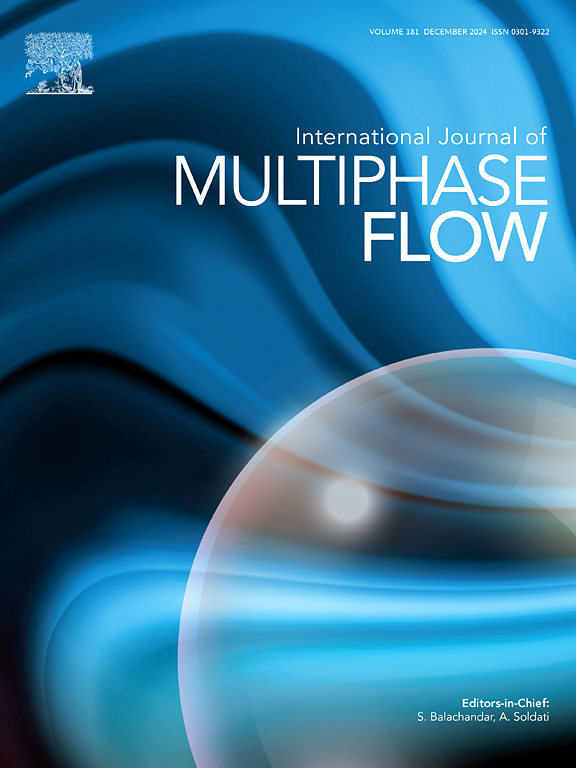Proper orthogonal decomposition analysis of turbulent natural convection in an air–water system with evaporation across the free surface
IF 3.6
2区 工程技术
Q1 MECHANICS
International Journal of Multiphase Flow
Pub Date : 2025-05-13
DOI:10.1016/j.ijmultiphaseflow.2025.105273
引用次数: 0
Abstract
In this paper, we analyze the properties of turbulent natural convection in a water-air system via Proper Orthogonal Decomposition (POD). The flow domain is an open-top cuboid uniformly heated from below, while the water and air are separated by an evaporative interface. Direct numerical simulations of this problem were presented in an earlier publication of ours; herein we investigate in detail the emerging flow structures and the interaction between the two phases. In the water, the flow is organized around a dominant convective roll. In the gas the flow is due to combined thermal-concentration convection. The flow pattern is more complex and consists of an outer circulation plus an inner dual-roll structure with one roll above the other. First we discuss spectra of the thermal fluctuations. In the gas, the spectrum is bimodal. The high-frequency peak is due to natural convection while the low-frequency one is due to the interaction with water at the free surface. Then, we present the results of our POD analysis and elaborate on the properties of the dominant spatial and temporal modes. The spectra of the temporal modes are also examined herein. Our analysis shows that there is high correlation and coherence between the low-frequency signals in the dominant modes of the two phases, which implies that the convective patterns in the two phases influence each other. We also present the reconstructed snapshots with the dominant POD modes and discuss their influence. Our analysis shows that they provide a fairly accurate approximation of the instantaneous flow patterns. Further, in the water, the dominant mode modifies the length of the main convective roll, whereas the second mode tends to rotate its impingement point.
自由表面蒸发的空气-水系统湍流自然对流的正交分解分析
本文利用固有正交分解(POD)分析了水-空气系统中湍流自然对流的性质。流域是一个从下均匀加热的开顶长方体,而水和空气被蒸发界面分开。这个问题的直接数值模拟在我们早期的出版物中提出;在此,我们详细研究了新兴的流动结构和两相之间的相互作用。在水中,流动是围绕着一个主要的对流滚动组织的。在气体中,流动是由于热浓缩对流的结合。流型更为复杂,由一个外循环加一个内双辊结构组成,其中一个辊在另一个辊之上。首先讨论热波动的谱。在气体中,光谱是双峰的。高频峰是由自然对流产生的,低频峰是由自由表面与水的相互作用产生的。在此基础上,介绍了POD分析的结果,并阐述了主要时空模态的特征。本文还研究了时间模的谱。我们的分析表明,在两个相位的优势模态中,低频信号之间存在高度的相关性和相干性,这意味着两个相位的对流模式相互影响。我们还给出了具有主要POD模式的重构快照,并讨论了它们的影响。我们的分析表明,他们提供了一个相当准确的近似瞬时流动模式。此外,在水中,主导模式改变了主对流滚转的长度,而第二模式倾向于旋转其撞击点。
本文章由计算机程序翻译,如有差异,请以英文原文为准。
求助全文
约1分钟内获得全文
求助全文
来源期刊
CiteScore
7.30
自引率
10.50%
发文量
244
审稿时长
4 months
期刊介绍:
The International Journal of Multiphase Flow publishes analytical, numerical and experimental articles of lasting interest. The scope of the journal includes all aspects of mass, momentum and energy exchange phenomena among different phases such as occur in disperse flows, gas–liquid and liquid–liquid flows, flows in porous media, boiling, granular flows and others.
The journal publishes full papers, brief communications and conference announcements.

 求助内容:
求助内容: 应助结果提醒方式:
应助结果提醒方式:


